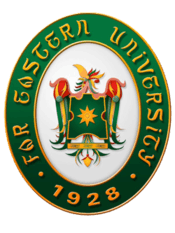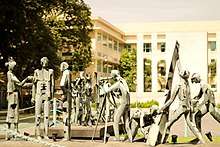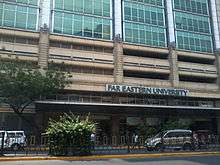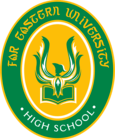Far Eastern University
|
Pamantasan ng Malayong Silangan | |
 | |
| Latin: Universidad de Extremo Oriente | |
| Motto | Sapientia Regnat (Latin) |
|---|---|
Motto in English | Wisdom Rules |
| Type | Private, Research, Non-sectarian, Autonomous Status |
| Established | 1928 |
Academic affiliations | ASAIHL, AUN, IAU, AACSB, PACU, PACUOCA, PAASCU |
| Chairman | Aurelio Reyes Montinola III |
| President | Michael M. Alba |
| Undergraduates | 24,519 (AY 2016-2017) [1] |
| Postgraduates | 374[1] |
| Location |
Lerma St., Morayta, Manila, Philippines 14°36′14″N 120°59′08″E / 14.6038°N 120.9855°ECoordinates: 14°36′14″N 120°59′08″E / 14.6038°N 120.9855°E |
| Campus | 40,000 m² |
| Colors |
Green |
Sporting affiliations | UAAP |
| Mascot | Tamaraw nicknamed TamTam |
| Website |
www |
 | |
Far Eastern University (FEU) (PSE: FEU) in the University Belt area, West Sampaloc, City of Manila, is a nonsectarian private university in the Philippines. Created by the merger of Far Eastern College and the Institute of Accountancy (now Institute of Accounts, Business and Finance), FEU became a university in 1933 under the guidance of first president Dr. Nicanor I. Reyes, Sr. It has been noted as the leading proprietary university in the Philippines.[2] FEU's campus is noted for a number of historical buildings preserved from the first half of the 20th century.
History
Far Eastern University was founded in 1933 when the Far Eastern College and the Institute of Accounts, Business and Finance (IABF) merged.[2][3] Far Eastern College (now Jose Rizal University), founded in 1919 by Don Vicente Fabella, had been a liberal arts college in Quiapo; the IABF had been established (originally under the name Institute of Accountancy) by Dr. Francisco T. Dalupan Sr. and Dr. Nicanor I. Reyes, Sr., head of the Department of Economics of the University of the Philippines, with a number of other prominent educators in 1928.[3][4] IABF had been originally predominately used by night students, and the new university, which was supported by the tuition provided by its students rather than government grants.[3][4]
In its earliest days, FEU was housed in a converted tobacco factory already present on the four hectare (nearly 10 acre) plot which would eventually host the current campus.[3][4] During World War II, the campus was occupied by the Imperial Japanese Army, who left only its shell unharmed.
Reyes Sr. was appointed the first president of the University, which spent its early years establishing several of its institutes, including those of Law and Technology. Reyes commissioned Brother in law Arch. Pablo S. Antonio Sr., who would later be titled National Artist of the Philippines, to construct a building for the school.[5] In 1939, the Nicanor I. Reyes Hall, which would later house the library and Institute of Accounts, Business and Finance, opened. Two other buildings by Antonio, the Girls’ High School Building and Boys High School Building, followed in 1940 and 1941,[5] by which year FEU had 10,000 registered students, with an international student population of 400.[6][4] Dr. Nicanor I. Reyes Sr. having been killed during the occupation, Atty. Hermenegildo Balbino Reyes was appointed the second president of the University when it reopened in 1945.[4]
Thereafter, FEU continued to expand, with the opening of a Science Building and the establishment of the Institute of Medicine and the School of Nursing. In 1955, the FEU hospital was opened. Humanities were introduced in 1959, and in 1970 the Institute of Architecture and Fine Arts opened. Also in 1970, the for-profit status of the Institute of Medicine, School of Medical Technology, FEU Hospital and the Student Health Service Clinic was altered, when these were converted in the FEU Dr. Nicanor I. Reyes Medical Foundation, a non-stock, non-profit educational foundation.[4]
University emblems

- The University Seal: The FEU Coat of Arms consists principally of an eight-pointed golden star representing the eight main academic discipline offered by the University and supported by heraldic sari-manok motif, in full colors.[7]
- The legendary Sarimanok projects the nationalistic spirit upon which the University was founded. It also serves as the link between the past and present.[8]
- The University Colors: Gold represents the golden opportunity for the University to serve the youth and her alumni to serve the country. Green is for hope, representing Rizals "Fair hope of the Fatherland.".[8][9]
- The University Font: The DellaRobbia BT is the official font of FEU. In the past, FEU's official font was inspired by the Baybayin and designed by Galo B. Ocampo.[10]
- The Tamaraw is the mascot of every FEU athletic team. Hence, it is the pet name of every FEU student (Tams). Known scientifically as “Bubalus mindorensis”, it is a rare animal found only in the island of Mindoro. Symbolically enough, the Tamaraw is one of the most intelligent, pugnacious and aggressive of our animal species just as the University known for its advanced, progressive policy in contemporary education.[8][11]
- The Memorial Quadrangle is a Manila landmark and a favorite backdrop for picture-taking in the campus. Erected in memory of the University Founder, it consists of a 65-foot flagpole on a platform surrounded on all sides with brass sculpture by National Artist Vicente Manansala which interprets the late founder's philosophy of education.[8]
- The Mace is the symbol of the office of the University President.[8]
Manila Campus

Among the buildings on FEU's campus complex, five by late Arch. Pablo S. Antonio Sr. garnered recognition for FEU in 2005 from the United Nations Educational, Scientific and Cultural Organization (UNESCO), who bestowed the Asia Pacific Heritage Award for Cultural Heritage on the university for "the outstanding preservation of its Art Deco structures."[5] The buildings include the Nicanor I. Reyes Hall, the FEU East Asia College of Engineering and Computer Studies, the Law and Nursing Building, Auditorium/Administration Building and the Science Building. The Cultural Center of the Philippines also recognized the historical legacy of the buildings with a marker. Other historical buildings on the campus include the 1950s FEU Chapel, FEU Hospital, and the Arts and Sciences Building, which also represent the International Style.

History
| Presidents of Far Eastern University |
| Nicanor Icasiano Reyes Sr., 1934-45 |
| Hermenegildo Balbino SanAgustin Reyes, 1945-46 |
| Clemente Q. Uson, 1946-47 |
| Belen Enrile Gutierrez, 1947-49 |
| Vidal A. Tan, 1949-52 |
| Teodoro T. Evangelista Sr., 1952-71 |
| Nicanor Mendoza Reyes Jr., 1971-82 |
| Belen Enrile Gutierrez, 1982-85 |
| Josephine S. Cojuangco-Reyes, 1985-89 |
| Felixberto C. Sta. Maria, 1989-1995 |
| Edilberto C. de Jesus, 1995-2002 |
| Lydia B. Echauz, 2002–12 |
| Michael M. Alba, 2012–present |
During the 1930s, there was a heavy influence of American culture especially in the field of technology and construction that was reflected in the lives of the Filipinos. Concrete and steel were used by the Americans and was found to be the suitable materials for the tropical environment. These were materialized by Arch. Pablo S. Antonio Sr., a National Artist in creating the FEU campus buildings that reflected both the university's and the country's vision and showed his personal transition from Art Deco to the International Style.[5][12] The buildings were constructed between the years 1939 to 1950.
Nicanor Reyes Hall
The Nicanor Reyes Hall is a long, low-rise U-shaped building facing Quezon Boulevard. The distinct character of the massive facade are the sets of protruded vertical volumes located on both ends of the structure.
Attention to details is another design focus of the architecture of Pablo S. Antonio Sr.[12] The heavy influence of Art Deco in his architectural style is seen even in transitional elements like the stairs. The outdoor stairs that joins the walkway at the second floor has layers of thin concrete slabs that swirl in waves above the rigid geometry of the handrail.
The physical envelope of the Main Building, now Nicanor Reyes Hall, is one of the examples of classic Philippine Art Deco emphasizing the play on geometric forms.[12]
Administration Building
The FEU Administration Building was also constructed by Arch. Pablo S. Antonio Sr. a decade after the Nicanor I. Reyes Hall. It is located at the opposite end of the campus quadrangle that features a facade with geometric architectural details, horizontal windows, and a balcony that extends into a viewing deck at the second floor to observe the activities in the quadrangle.
The Art Deco - inspired FEU Theater can be found inside the Administration Building. it also houses the works of the known Filipino artists, most of them in the Art Deco era.[12] One work is a mural done by Antonio Gonzales Dumlao in the Administration Building which conveys the university mission. At the quadrangle, there is a group of Vicente Manansala copper-sheet sculptures which represent the professional disciplines offered by the university. There are also murals from National Artist Botong Francisco hung in the chapel. Francesco Riccardo Monti also did a bas-relief depicting the American Regime in the Philippines.[12]
The former Main Building is one of the twin edifices flanking the Administration Building. It is the third building designed by Arch. Pablo S. Antonio Sr. also in the Art Deco Style. Constructed in 1941, it is used to house the Boys' High School which is originally an early basic education program of the university.
Admission Building
Built in 1940, the Admission Building is the mirror image of the Architecture & Fine Arts Building. The building was initially used by the Girls' High School and in 1983 became home to the Institute of Medicine (which now has its own campus in Fairview, Quezon City). In 2015 the building has been renovated and changed its name from FEU-East Asia College Building to the FEU Main Building which was used before by FEU-EAC students. Since there is a newly created building for EAC students they were transferred now to the FEU-Institute of Technology Building located just across FEU campus in Ricardo Papa street.
Science Building
The seven-story building erected in 1950 was also designed by Arch. Pablo S. Antonio Sr. in what is considered a transition of style between Art Deco and the post World War 2 International Style. In 1990, an earthquake caused structural damages to the building making it necessary to demolish the top two floors. By the late 2013 a sixth floor was added. The building now houses the Department of Medical Technology, Psychology, Biology and Mathematics.
Accreditations and Recognitions
Conferred the Autonomous University status by CHED, FEU Manila currently meets the highest regulatory standards set for Philippine HEIs. FEU Manila has twenty one accredited programs. In addition, eight of the undergraduate programs have level 4 – the highest – accreditations from the Philippine Association of Colleges and Universities Commission on Accreditation (PACUCOA), while the rest are on their way to obtaining ever higher accreditation levels.
FEU Manila’s international recognitions include being an associate member of the ASEAN University Network – Quality Assurance (AUN-QA), one of less than ten Philippine HEIs with the distinction; a member of the Association to Advance Collegiate Schools of Business (AACSB) for its BS Accountancy, BS Business Administration, and Master of Business Administration programs; and an associate member of the International Centre of Excellence in Tourism and Hospitality Management (THE-ICE) for its BS Tourism Management and BS Hotel and Restaurant Management programs.
Academic institutes
- Institute of Accounts, Business and Finance (IABF) | Center of Development in Business Education
- Institute of Architecture and Fine Arts (IARFA)
- Institute of Arts and Sciences (IAS)
- Institute of Education (IE) | Center of Excellence in Teacher Education
- Institute of Nursing (IN)
- Institute of Tourism & Hotel Management (ITHM)
Arts and Culture
Events
Musica FEUROPA - is an annual national choral competition in partnership with the European Union (EU).
Tatak Tamaraw - is a week long event that welcomes freshmen to the FEU community. It also orients them on policies, support services, and the vibrant campus life.
Tam Rally - parade and performances by FEU Athletes and Cultural Groups.
Tam Hunt, a student organizations membership fair.
Concierto Piyu, a concert held during foundation day.
Paskong Piyu - university-wide Christmas celebration and inter-institute sing and dance competition.
Publications
Key Institutional Materials and University Publications
- Annual Report
- President’s Report
- TAMBULI
FEU Senior High School

Established in June 2013, FEU High School Inc. offers Senior High School, specifcally, Grades 11 and 12; Academic Strands Offered:
- Science Technology Engineering and Mathematics (STEM)
- Humanities and Social Sciences (HUMSS)
- Accountancy, Business and Mathematics (ABM)
- General Academic Strand (GAS)
Notable alumni
Governance and public service
- Corazon Aquino, President of the Philippines, 1986–1992, first female elected head of state in Philippines; Leader of the first successful non-violent revolution for democracy against dictatorial rule; Laureate of the Eleanor Roosevelt Human Rights Award, United Nations Silver Medal, Prize for Freedom Award, Ramon Magsaysay Award, and Pearl S. Buck Award
- Artemio Panganiban - Former Chief Justice and Associate Justice of the Supreme Court of the Philippines
- Jose Nolledo - Member, Philippine Constitutional Commission of 1986; Delegate, Philippine Constitutional Convention of 1971
- Eddie Ilarde - Former Philippine Senator[14]
- Neptali Gonzales II - Former Majority House Leader of the House of Representatives of the Philippines
- Manuel Collantes - Former Secretary of Foreign Affairs and Former Ambassador to the United Nations[15]
- Patricia Sto. Tomas - Former secretary of DOLE; Former Chairman of Civil Service Commission and Development Bank of the Philippines; and Current Director of Land Bank of the Philippines[7]
- Pantaleon Alvarez - Former House speaker for the House of Representatives of the Philippines
Business
- Henry Sy - Chairman of SM Group of Companies, Banco de Oro, Owner of National University (Philippines) and NU-APC Makati
- Ramon S. Ang - President and CEO of the San Miguel Corporation[16][17]
- Lucio Tan - Chairman of Tan Group of Companies and University of the East
- Alfonso Yuchengco - Chairman of Yuchengco Group Of Companies and Mapúa University
Media
- Ramon Revilla Sr. - actor and former Senator of the Philippines
- Vice Ganda - comedian and television host actor[18][19][20]
- Bert Marcelo - comedian and actor
- Betty Mendez Livioco - radio host
- Juan Rodrigo - actor[21]
- Wendy Valdez - actress and Binibining Pilipinas - Tourism 2005[22]
- Jessy Mendiola - actress[23]
- Maja Salvador - actress
- Gloc 9 - rapper
- Chris Tsuper - radio DJ[24]
Sports
- Victor Pablo - Philippine Basketball Association (PBA) player
- Arwind Santos - Philippine Basketball Association (PBA) player[25]
- Rachel Anne Daquis - Volleyball Player, Model[26]
- Jeffrei Chan - Philippine Basketball Association (PBA) player and Smart Gilas Pilipinas player
- Johnny Abarrientos - Retired Former Philippine Basketball Association (PBA) player
- Mark Barroca - Philippine Basketball Association (PBA) player and Gilas Pilipinas player
- Aldrech Ramos - Philippine Basketball Association (PBA) player and Gilas Pilipinas player
- Jonas Villanueva - Philippine Basketball Association (PBA) player
- Terrence Romeo - Philippine Basketball Association (PBA) player and Gilas Pilipinas player
- RR Garcia - Philippine Basketball Association (PBA) player and Gilas Cadets player
- Chris Exciminiano - Philippine Basketball Association (PBA) player
- JR Cawaling - Philippine Basketball Association (PBA) player and Gilas Cadets player
- Elma Muros - athlete, heptathlon champion
- Lydia de Vega - athlete, gold medalist
Arts and culture
- Edwin Cordevilla - poet and journalist[27]
- Ligaya Fernando-Amilbangsa - cultural researcher, educator, artist and Ramon Magsaysay Awardee[28]
- Alejandro Roces - author, essayist, dramatist and a National Artist of the Philippines for literature[29]
Other members of FEU Group of Schools
- Far Eastern University – Institute of Technology[30]
- College of Engineering
- College of Computer Studies (CCS) | Center of Development in I.T. Education
- Department of Graduate Studies
- Far Eastern University - Nicanor Reyes Medical Foundation[31]
- Institute of Medicine
- School of Medical Laboratory Science
- School of Physical Therapy
- School of Nursing
- School of Respiratory Therapy
- School of Pharmacy
- School of Nutrition and Dietetics
- School of Radiologic Technology
- Far Eastern University – FERN College (FEU Diliman) [32]
- Far Eastern College – Silang (FEU Cavite)[33]
- Far Eastern University – Makati (extension of the main campus) [34]
- Institute of Law and Ext. of Institute of Accounts, Business and Finance
- Far Eastern University – Alabang, Muntinlupa[35]
- Far Eastern University – Roosevelt College[36]
Athletics
Among the many athletes who have attended FEU are Alberto Nogar Sr, Lydia De Vega, Elma Muros, Anthony Villanueva, and Johnny Abarrientos.[37] FEU's teams are named after the tamaraw, a buffalo with a reputation for ferocity.[38]
References
- 1 2 "President's Report 2016" (PDF). Far Eastern University Investor's Relations Relations. Retrieved 8 February 2018.
- 1 2 Rüegg, Walter (2004). Universities in the nineteenth and early twentieth centuries (1800-1945). A History of the University in Europe. 3. Cambridge University Press. p. 213. ISBN 0-521-36107-9.
- 1 2 3 4 Gupit, Jr., Dr. Fortunato, ed. (1986). Elements of Public Speaking (4th ed.). Rex Bookstore. p. 340. ISBN 971-23-0415-9.
- 1 2 3 4 5 6 "The History of FEU". feu.edu.ph. Archived from the original on 2007-06-09. Retrieved 2009-09-10.
- 1 2 3 4 Ortiz, Margaux (2007-01-15). "Art Deco buildings thrive on FEU campus". Philippine Daily Inquirer. Archived from the original on 2012-10-12. Retrieved 2009-09-10.
- ↑ de Jesus, Edilberto C. (2002). "Muddling Through: Development Under a "Weak" State". In Wan-Ling Wee, C.J. Local cultures and the "new Asia": the state, culture, and capitalism in Southeast Asia. Social Issues in Southeast Asia Series. 24. Institute of Southeast Asian Studies. p. 70. ISBN 981-230-123-2.
- 1 2 FEU Publication - Student Handbook AY 2014-2015
- 1 2 3 4 5 IABF Bulletin of Information 2005-2007
- ↑ FEU Publication
- ↑ name="feu publication"
- ↑ The FEU Advocate - University Profile
- 1 2 3 4 5 Montinola, Lourdes (2010). Art Deco in the Philippines. Manila: ArtPositAsia. ISBN 978-971-057-905-1.
- ↑ "FEU Senior High School". shs.feu.edu.ph. Retrieved 2018-07-11.
- ↑ Magbanua, Mijares & Associates, ed. (1967). The Philippines Officials Review '67. Pasay City, Philippines: M & M Publications. p. 185.
- ↑ "Manuel Collantes is dead; 91". Philippine Daily Inquirer. 2009-05-29. Archived from the original on 2009-05-30. Retrieved 2009-06-14.
- ↑ https://www.forbes.com/profile/ramon-ang/
- ↑ http://www.philstar.com/business/2012-07-03/823758/phenomenal-rise-ramon-ang
- ↑ http://www.spot.ph/peopleparties/55847/filipino-celebrities-and-where-they-went-to-college#/photo-2843-30
- ↑ http://www.interaksyon.com/interaktv/caption-this-arwind-santos-vice-ganda-watch-the-uaap-finals
- ↑ 5 Showbiz Artists from Far Eastern University | http://www.push.abs-cbn.com
- ↑ 5 Showbiz Artists from Far Eastern University | http://www.push.abs-cbn.com
- ↑ 5 Showbiz Artists from Far Eastern University | http://www.push.abs-cbn.com
- ↑ 5 Showbiz Artists from Far Eastern University | http://www.push.abs-cbn.com
- ↑ FEU Holds Grand Alumni Homecoming 2014 | http://www.feu.edu.ph
- ↑ Caption This: Arwind Santos, Vice Ganda watch the UAAP finals | http://www.interaksyon.com/
- ↑ http://www.abs-cbnnews.com/sports/10/08/14/look-feu-alumni-show-support-tamaraws
- ↑ "Edwin Cordevilla", Wikipedia, 2018-05-24, retrieved 2018-08-03
- ↑ "Fernando-Amilbangsa, Ligaya • The Ramon Magsaysay Award Foundation • Honoring greatness of spirit and transformative leadership in Asia". rmaward.asia. Retrieved 2018-07-31.
- ↑ "Alejandro Roces", Wikipedia, 2018-04-25, retrieved 2018-08-03
- ↑ "IT & Engineering School in Philippines - FEU Tech". www.feutech.edu.ph. Retrieved 2018-07-31.
- ↑ http://www.feu-nrmf.ph/
- ↑ http://www.feudiliman.edu.ph/
- ↑ http://www.feucavite.edu.ph/
- ↑ "FEU Makati | Far Eastern University". www.feu.edu.ph. Retrieved 2018-07-31.
- ↑ https://www.feualabang.edu.ph/
- ↑ "Roosevelt College, Inc". Roosevelt College, Inc. Retrieved 2018-07-31.
- ↑ University, Far Eastern. "FEU Green & Gold Awards". www.feu.edu.ph. Retrieved 2018-08-03.
- ↑ Huffman, Brent (2007-01-02). "Bubalus mindorensis: Tamaraw". www.ultimateungulate.com. Ultimate Ungulate.com. Retrieved 2009-09-15.